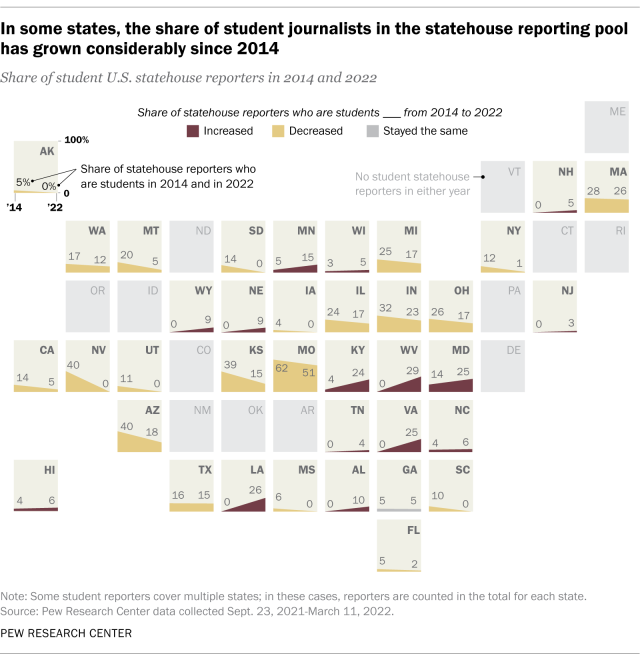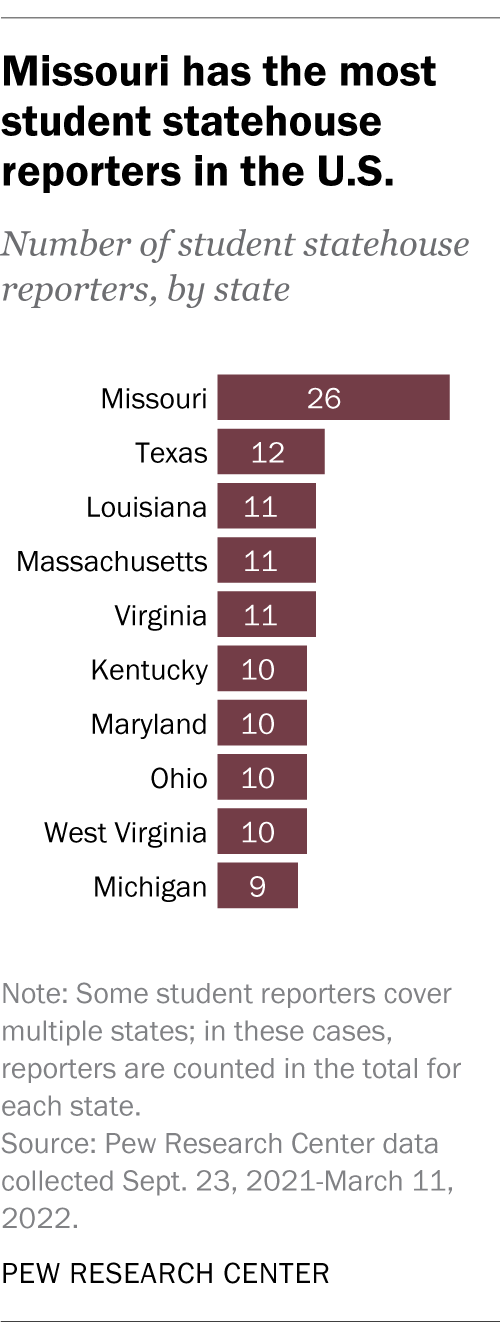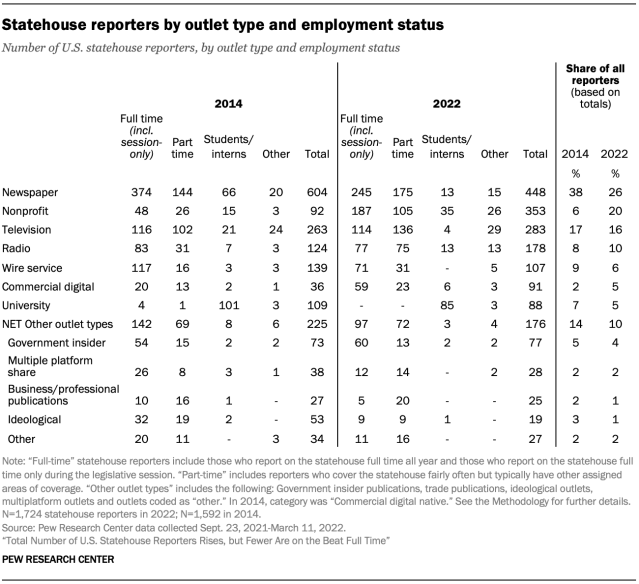CORRECTION (Oct. 31, 2023): This post has been corrected throughout to reflect new information, received in August 2023, that reduced the number of student statehouse reporters in Nebraska from 40 to three. Many figures in this analysis were changed in the process, including in graphics and the table. Although rankings by state were affected, the new information does not change the overall conclusions of the study. For questions, please email Pew Research Center.
Student journalists account for around one-in-ten state capitol reporters in the United States (9%), according to a recent Pew Research Center study. In some states, however, they account for a much larger share of the statehouse press corps, with notable increases in some places since 2014.

Student statehouse reporters often work for a university-run news service or as student interns at news organizations. University and college outlets sometimes have a model similar to wire services and some nonprofit newsrooms, in which their reporting is carried by a number of local news outlets. The number of students often fluctuates depending on the semester and can change substantially when student reporting programs open or close.
This blog post draws on data from Pew Research Center’s 2022 and 2014 studies of statehouse reporting. For details on the 2022 statehouse report, read its methodology. For details on the 2014 statehouse report, read its methodology.
Students covering the statehouse are defined here as interns or college or university students, typically working at a university-run news service or as a student intern at a news organization. These reporters often cover the statehouse for short periods of time, such as a semester.
Some student reporters cover multiple states; in these cases, reporters are counted in the total for each state.
This analysis draws from a report funded by The Pew Charitable Trusts, with generous support from the John S. and James L. Knight Foundation and Arnold Ventures. It is the latest report in Pew Research Center’s ongoing investigation of the state of news, information and journalism in the digital age, a research program funded by The Pew Charitable Trusts, with generous support from the John S. and James L. Knight Foundation.

In Missouri, 51% of all reporters covering the state capitol this year – 26 of 51 – are students. Missouri has both the highest number and share of student statehouse reporters of any state.
Student reporters now also account for around a quarter of all statehouse reporters in Louisiana (11 of 42, or 26%) and Virginia (11 of 44, or 25%). Neither state had student statehouse reporters in 2014, the last time the Center conducted a similar tally. Both are now among the states with the highest overall number of student statehouse reporters, trailing only Missouri (26) and Texas (12) and tied with Massachusetts (11).
Kentucky and West Virginia have also seen notable increases in student statehouse reporters since 2014. Both states have 10 such reporters this year, up from one in Kentucky and none in West Virginia eight years ago. Student journalists now account for 24% of all statehouse reporters in Kentucky (10 of 42) and 29% in West Virginia (10 of 34).
Christopher Drew, director of Louisiana State University’s Manship School News Service, described in an interview for the Center’s recent report how student capitol journalists provide important content for outlets that don’t have statehouse reporters.
“We’ve built it up to where 89 news sites in Louisiana and Mississippi have now run at least one of our stories,” he said. “They get professional-quality coverage. Then, a lot of these papers are crying for stories and legislative coverage. It’s great for readers and good public service for the school.”
Not all states have seen increases in the number of student reporters at the statehouse, however.
While Missouri has more student statehouse reporters than any state, its total is considerably lower today than in 2014 (26, down from 51).
Arizona, Michigan and Ohio, which tied for the third-highest total of student statehouse journalists in 2014 with 16 each, saw their numbers fall to seven, nine and 10, respectively. California, Illinois and Kansas went from having 11 each in 2014 to having single-digit totals today (five in California, six in Illinois and four in Kansas).
Nationally, the total number of statehouse reporters – counting full- and part-time reporters across all media types, as well as student journalists – has increased since the Center’s previous tally eight years ago. But the number of full-time statehouse reporters has declined, while the number of reporters covering statehouses less than full time has gone up.
Most student statehouse reporters in the U.S. (53%, or 85 of 159) work for university and college news outlets. In 2014, by comparison, 101 of 223 student statehouse reporters (45%) worked for such outlets.

The number of students and interns covering state government for newspapers and television stations, however, fell by roughly 80% (from 66 to 13 and from 21 to four, respectively) since 2014.
Amid the overall increase in nonprofit newsrooms covering statehouses, the number of student reporters at these outlets more than doubled, from 15 reporters in 2014 to 35 today.
The remaining student statehouse reporters work at radio stations (13), commercial digital outlets (six) or other outlets (three).



